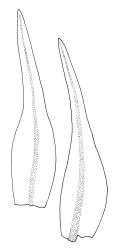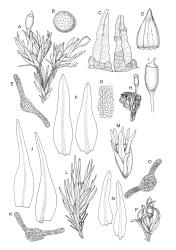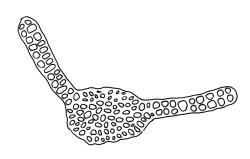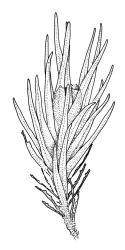- ≡ Muelleriella angustifolia (Hook.f. & Wilson) Dusén, Bot. Not. 1905: 304 (1905)
Plants in nearly black cushions or tufts c. 1–3 cm diam. Stems erect, usually unbranched or once-branched, sparsely beset with smooth brown rhizoids, c. 5–8 mm. Leaves stiffly secund to twisted and curved when dry, loosely spreading to weakly secund when moist, narrowly lanceolate to broadly subulate from an oblong-ovate or oblong base, gradually narrowed to an acute apex, bistratose above, entire, plane, mostly 3.0–4.0 mm; margins 2–3-stratose; mid and upper laminal cells irregularly rounded to oval-rectangular, a few usually oblate, smooth, mostly 6–8(–10) µm wide; basal interior cells rectangular, mostly (18–)30–60 × 7–11 µm, the basal portion of larger leaves bordered by 1 row of ± clear cells that lack thickened transverse walls. Costa as per genus, stout, elliptic in cross-section at mid leaf, somewhat obscured by laminal cells near apex. Gemmae absent.
Gonioautoicous. Perichaetial leaves larger (to c. 4.7 mm) but otherwise similar to vegetative. Perigonia gemmiform on lower stems or terminal on separate short branches. Setae stout, 0.3–0.7(–1.3) mm; capsules globose-ovate when moist, oblong-ovate when dry, abruptly contracted to the seta, deeply immersed and inconspicuous, yellow-brown, the mouth reaching ½ or less the length of the perichaetial leaves, 0.8–1.1 × 0.6–0.9 mm; exothecial cells rectangular, 22–33 µm long; stomata immersed, restricted to lower half of capsule; annulus apparently absent; operculum not seen. Peristome single; exostome teeth 16, spreading when dry, recurved when old and dry; irregularly papillose or papillose-striate; preperistome present, 1–4 cells high, sometimes not visible beyond the capsule mouth; endostome absent. Calyptra conic-mitrate, naked. Spores multicellular, irregularly spherical to ellipsoid, mostly 40–60(–80) µm in greater dimension, papillose.
Vitt 1976, figs 8–15, 33, 35, 37 (as Muelleriella angustifolia).
Orthotrichum angustifolium is characterised by having gradually narrowed, lanceolate to broadly subulate leaves. The costa is composed entirely of stereids and, except for the extreme apex, is not covered by shorter laminal cells. The upper leaf lamina is more consistently bistratose (sometimes tristratose at margin) than in O. crassifolium. The capsules are deeply immersed in the leaves, with the mouth reaching only to the middle (or less) of the enclosing perichaetial leaves. In shape, the capsules are narrowly ovate to oblong-ovate when dry and become nearly globose and sharply contracted to the setae when moist. The seta is rarely, if ever, longer than the capsule.
If capsules are not observed, O. angustifolium could easily be mistaken for a large species of Andreaea. Andreaea subulata, for which the present species would most likely be mistaken, is a red-brown plant with generally much shorter (<2 mm) leaves, ill-defined costae and ill-defined upper laminae. There are also marked differences in areolation and the sporophytes are unmistakably different.
C (Saint Col ridge, Beeman Hill, Mt Filhol, Jacquemart I.).
Endemic.
On rock faces from c. 150–300 m. It is found commonly with Andreaea acutifolia and A. subulata on siliceous cliff faces in exposed situations. According to C. Meurk (pers. comm., 20 Feb. 2003) the sites from which O. angustifolium is known receive "low to moderate nutrient inputs from the sea".
Vitt’s (1976, p. 98) suggestion that Sainsbury & Allison (1962) recorded this species from the Snares and the Otago coast was based on a misinterpretation of that publication.







